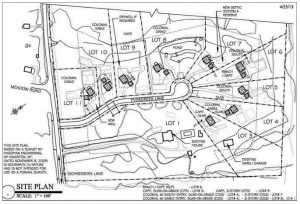
The concept of zero net energy buildings is not new. The first Passivhaus buildings—residences using a rigorous standard for energy efficiency that results in ultra-low energy usage—were constructed in Germany in 1990; in California, the fifth largest county prison in the US with a capacity of 4,000 inmates has been creeping towards zero net energy consumption for the past decade; and the 2007 U.S. Energy Independence and Security Act requires that all new Federal buildings and major Federal building renovations meet incremental targets leading to zero net energy consumption by 2030.
Until recently, environmentally conscious individuals could have a zero net energy home custom-designed and built. Now, New Paltz is joining a small group of progressive centers building entire zero net energy communities; the Esopus-based company Greenhill Contracting, Inc., is building The Preserve at Mountain Vista, a nine-home, zero net energy community off Shreiber Lane. The homes, ranging from 2,050 to 2,350 square feet and from $399,900 to $429,900, are being sold by Gardiner Real Estate Broker Wendie Reid. Green Acres, in the Village of New Paltz, a previous zero net community by the same company, already has seven occupied homes with more in the planning stage.

A site plan of The Preserve. Image courtesy Wendie Reid.
Those new to the zero net concept should note that there is a difference between green building—also known as sustainable architecture—and zero net energy structures. Green buildings tend to be “green” in a broader range of ways than zero net structures. They are often built with recycled, locally produced and sustainably harvested materials, use measures to control storm water runoff and soil erosion, are landscaped with native plants, and so on. The main focus of zero net buildings, though, is to actually produce a surplus of energy over the course of the year. This is done by using superior insulation, triple-pane windows and heat recovery and structure that is much more air tight in order to avoid heat and cooling loss. The homes in The Preserve are made of Insulating Concrete Forms (ICFs)—steel reinforced concrete sandwiched between layers of foam—and the resulting “thermal envelope” is so tight that they make very efficient use of the energy they produce. As changes to New York State Building Codes incorporate more and more energy efficiency requirements into all new buildings, a baseline comparison with standard construction becomes more difficult. Nevertheless, standard green buildings can generally be expected to be 20% more energy-efficient than current NY State Code baselines, while we should expect 70-80% more efficiency from zero net structures.
Dayle Zatlin, Assistant Director of Communications at the New York State Energy Research and Development Authority (NYSERDA), says that NYSERDA encourages all efforts to build homes that are more energy-efficient than the state requires, but their official definition of zero net energy is, in part, “a home that produces as much electricity as it draws from the electric grid, resulting in monthly utility bills that net to zero over a year’s time, with the electricity exported to the grid being purchased from the homeowner by the utility.”
She acknowledges, however, that the concept of zero net is complicated, and that NYSERDA typically refers to homes as being “designed to be” zero net. “The fact is,” Ms. Zatlin says, “a zero net building, regardless of how perfectly it is designed and built, cannot be judged in isolation of its occupants.” The homes in the Preserve, for example are designed to be zero net at temperatures of 70 degrees in winter and 68 in summer. If occupied by a family that likes more extreme temperatures and hour-long showers, it might not net out to zero. That same house, if later sold to “more conscientious users” could do very well.
Life without an oil or electric bill certainly sounds like nirvana, and the US government clearly thinks so; homes in The Preserve qualify for up to $23,500 in Federal tax credits. As a model for the future though, zero net homes are not without issues; to get to zero net the solar panels can’t be shaded by trees or other structures. Though a 71-story zero net energy office building did open in China in 2009, it is unquestionably easier and more economical to achieve the zero net goal with suburban homes and office complexes rather than with dense, multi-story urban buildings. Regulatory bodies will have to take care not to derail one good thing (the move towards denser town centers coupled with the preservation of open space at greater distances) with another good thing (more and more suburban zero net buildings).
Right now though, zero net energy is the right answer to a good many questions. The US Green Building Council, a global leader in the green building movement, is currently offering an educational course entitled, The Problem with Net-Zero Buildings (and the Case for Net-Zero Neighborhoods). It’s good to see our local region at the forefront of what seems to be the wave of the future. For more general information visit www.zerohomes.org. For information about the developments in New Paltz contact Wendie Reid Realty at 845 255-5634.
